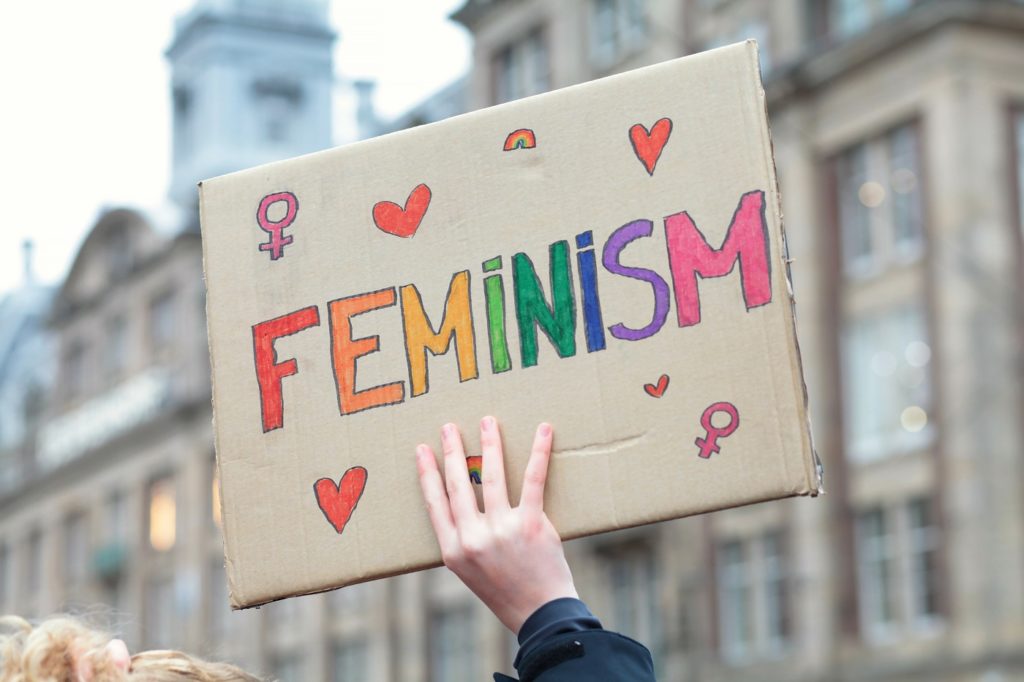In this month’s Sunday Long Read, Abigail Favale described “Feminism’s Last Battle.” This feminist armageddon centers on a simple question: “is a transgender woman a woman, or is a transgender woman a man?” After laying out the battle lines and offering an intellectual history of how we got to this point, Favale concludes that “to assert that power creates reality is to concede that woman is a construct—a concession that, for the feminist movement, will ultimately prove to be fatal.”
Today at Public Discourse, we are featuring brief responses to Favale’s essay by four writers: Erika Bachiochi, Margaret Harper McCarthy, Leah Libresco Sargeant, and Angela Franks.
Sex Differences, Power Politics, and Self-Mastery
Start your day with Public Discourse
Sign up and get our daily essays sent straight to your inbox.Erika Bachiochi
Abigail Favale has written a short but characteristically thoughtful history of the philosophical underpinnings of the last century of feminist thought. She’s right to dedicate a good portion of that history to Catharine MacKinnon, undoubtedly the most insightful feminist legal theorist of her generation. MacKinnon helped many to recognize how deeply the male body and male experience sets the standard for sex equality in US anti-discrimination law. As MacKinnon rightly argued in 1984, anti-discrimination law has difficulty handling those places in which women are “different” from men, starting with, as she says, the “original” one: “what to do about the fact that women actually have an ability men still lack, gestating children in utero.”
For this reason, I’d want to offer a bit of nuance to Favale’s characterization of MacKinnon’s theory as possessing a “Foucauldian flavor” in which all differences are “fabricated by patriarchal power and then taken as fact.” This is an accurate description with regard to gender differences; in light of thoroughgoing male normativity, MacKinnon was deeply skeptical we could be as confident as Carol Gilligan about “women’s ways of knowing.” This skepticism may have been due, in part, to MacKinnon’s being a lawyer; she was appropriately concerned about confining women legally to certain domains based on the prevalence of certain characteristics.)
But, as Favale well notes, biological differences, for MacKinnon, are not illusory. They are crucially real. In my view, retaining the sex/gender distinction as an analytical tool (and showing the latter’s dependence on the former—i.e., understanding gender as “sex lived out”) allows us to benefit from MacKinnon’s insight without following MacKinnon all the way down (and thereby sliding ineluctably into Butler). For MacKinnon, after all, the biological fact of reproductive difference exists at the origin; it’s not at all a product of power, as we see in Foucault and Butler. It’s just that, according to MacKinnon, from the very beginning, the real asymmetries in sex and reproduction were treated as hierarchical, with the male orientation (e.g., greater libido, reproduction outside oneself) as the socially dominant one. They were so dominant, in fact, that men could presume sex was their right and assume any resultant children (should they think of them at all) were simply women’s duty. (Cf., “And he shall rule over you,” Gen 3:16). Gendered social and familial assumptions, MacKinnon argues, flow from this original, legally-sanctioned, sex hierarchy.
Where MacKinnon errs is in regarding the hierarchical power disparity at the origins of sex as essential to the relations between men and women. There is no fall from grace in MacKinnon’s origin story. Thus, there’s no real possibility of redemption. There’s only power politics, the call for women to match power with power—not a plea for conversion, for love, for virtue.
Perhaps it’s for this reason that MacKinnon misses entirely the short-lived advance the nineteenth-century women’s movement made in the relations between the sexes. MacKinnon writes (in another essay in the volume Favale references):
[In the context of male sexual presumption] it becomes clear why the struggle for reproductive freedom has never included a woman’s right to refuse sex. In [the present] notion of sexual liberation, the equality issue has been framed as a struggle for women to have sex with men on the same terms as men: “without consequences.”
Here, MacKinnon perfectly captures how modern feminists have sought sex equality, with birth control and abortion as the movement’s sine qua non—as the way to manage the asymmetrical fact that women “gestate children in utero.”
But contra MacKinnon, the right to refuse sex is precisely the right, and freedom, that nineteenth century women’s rights advocates sought in their appeal for “voluntary motherhood.” Rather than debate birth control among themselves, as Favale suggests early in her essay, the nineteenth century women’s movement collectively rejected it. Instead, they argued for an entirely different approach to reproductive asymmetry, one that had everything to do with virtue.
These women acknowledged the biological asymmetries and power disparities at the root of sex and reproduction, just as MacKinnon would one hundred years later. But they (and the men who joined their cause) recognized the transformative effect sexual self-mastery could have on both men and women—and the relationship between them—in a way that MacKinnon’s determinism could not. Abandon this noble vision—and the essentially human task of acting in accord with our lofty dignity as rational creatures—and MacKinnon’s categories of “male-aggressor” and “female-victim” tend to describe reality all too well.
The nineteenth century women’s movement collectively rejected birth control. Instead, they argued for an entirely different approach to reproductive asymmetry, one that had everything to do with virtue.
It’s 2021! Do We Need Feminism?
Margaret Harper McCarthy
Feminism is in its death throes, but it is its own Grim Reaper. The problem, as Abigail Favale deftly shows, is that the central claim of the “Rads”—that “woman” is an idea imposed on women for purposes of oppression—inevitably gave rise to the claim of the “Trans”—that being a woman is itself an idea. Now men have access to all those private places for, and athletic competitions with, the weaker sex. Time to call the gravediggers!
I won’t be attending the funeral. Nor will I be joining the rescue crew to save the prelapsarian first wave from the subsequent fallen waves. Don’t get me wrong. I think women are every bit as human as men, a point lost on many before the first wave rolled up. But however good the causes of the first-wavers (woman’s suffrage, reforms in divorce and property law, etc.) the banner under which they marched couldn’t help but foster an abstract, disembodied notion of what it meant to be equally human.
To apply C.S. Lewis’s judgment about modern science to the situation, modern “equality” grew up in the wrong neighborhood. Thus, it is not enough, in my view, that first-wave feminists still believed in the nature of men and women. It is also a question of how they conceived of that nature, especially as concerns the relation between the two. In the wake of the enlightenment, “equality” could not but mean interchangeability and independence. Anything else must naturally be regarded as “inequality.”
Consider, for example the statement of one of the most prominent first-wave feminists, the one who re-wrote the Bible, Elizabeth Cady Stanton (1815-1902): “A woman should consider, first, what belongs to her as an individual, in a world of her own, the arbiter of her own destiny, an imaginary Robinson Crusoe with her woman Friday on a solitary island.” Consider too the disparagement, among the ranks of equity feminists, of those who advocated for women (and men, and society) on more embodied grounds (like “home protection”). Frances Willard (1839-98), the person chiefly responsible for bringing about woman’s suffrage, comes to mind. (Stanton didn’t like her.)
Consider the scores of women who entered public life in the 1920s and ’30s who advanced “maternalist” policies in tax, welfare, and labor law—things like a family wage for fathers, promotion of maternal care, “mother’s pensions” for widows, and protections against the industrial exploitation of women and children. These women had in view not androgynous and interchangeable individuals, but men and women who, as actual or potential fathers and mothers in a home, had distinct requirements and responsibilities. Accordingly, they pushed back against the meat-grinder of liberal “equality” that homogenized the difference, making men and women less indispensable to each other, and the culture more homeless.
As it happened, these women were routinely opposed precisely by the “equity feminists” of the day, in the National Woman’s Party, who were in lockstep with industrialists in opposition against such policies. This was all before the second wave!
Regardless of the historical debate, the question for us is this: do we need any form of feminism now? It’s 2021! So limited are the social barriers to women that feminists are telling women to stop “leaning out.” And now with the ubiquitous misandry and all the legal risks men face just to approach a woman, how does being a “feminist” help? Do we want to drive men entirely out of our lives? Doesn’t anyone want to go out on a date?! And just as a matter of self-respect, do we really want to keep perpetuating that one-sided account of violence (male) and victimization (female)? Suppose we were to start sharing the blame (equally, though differently) for the violence between us. Is “masculinism” OK too? Perhaps being a “feminist” is a just a strategy for dialogue with real feminists. Except for a few disagreements over questions about whether or not men and women are by nature in a state of permanent war, whether or not the differences between them matter in more ways than one, whether or not a woman’s capacity to bear life is a mark of distinction, we would agree on everything else. What is that? Suffrage?! Does anyone buy it?
Here’s another idea. How about a new “man and womanism,” “husband and wife-ism,” “father and motherism”? And how about an account of equality that is measured by our natural mutuality not the other way around. Then we can be together and do what only can be done together, namely “create history itself,” as Pope John Paul II put it.
However good the causes of the first-wavers (woman’s suffrage, reforms in divorce and property law, etc.) the banner under which they marched couldn’t help but foster an abstract, disembodied notion of what it meant to be equally human.
Becoming Grounded in the Real
Leah Libresco Sargeant
Women are not born, but rather become, skeptics of ontological claims about gender. Long before a girl is old enough to encounter the phrase “gender essentialism,” she has encountered enough false claims about what lines exist between men and women to be chary of conceding there is any essential difference.
Women in toxic purity cultures hear that they are living stumbling blocks for their male friends. Women in toxic promiscuity cultures hear that they can only understand their own bodies and desires through experimentation, and that any natural reluctance is prudery that must be desensitized and overcome. Women are told that their bodies are a problem—too prone to fertility—which they have to keep in careful check. Women are told that their bodies are a problem—too prone to effluvia—and that they must find a way to wean their child rather than inconvenience their employer.
Every woman has had the experience of being told that something about her womanhood is a problem for others, one that it’s her job to ameliorate. Many women have been told that there is something essential to being a woman that she lacks.
To give an account of the human person that is grounded in the real, we have to acknowledge the reality of these pressures and gender-based oppressions, while resisting the impulse to define womanhood down to the experience of this oppression.
One way to respond to a power-based understanding of reality is to offer an alternate grounding for identity—one that begins with vulnerability. Men and women are united in being dependent, rational animals. But the shape of our dependencies varies with our genders and other markers of our identities.
Women are marked by our capacity to be vulnerable in particular ways—especially our ability to sustain life (and for that new life to upend our own). Men often find that their own moments of vulnerability are anticipated and cushioned by a society that is built to suit male norms, while women find that their own needs are treated as inconvenient or strange. No one, man or woman, is an isolated individual, but women experience the falseness of the ideal of autonomy more vividly than men.
In A Secular Age, Charles Taylor argues we have lost touch with one way of understanding who we are. He contrasts the modern buffered self with what he terms the historical porous self. The buffered self draws a line of his or her own choosing between the self and the world, and trusts that he or she can choose what shapes them. The porous self is open to influence, to demands, to dependence. He or she exists in horizontal relationship to others and vertical relationship to the divine.
In order for men and women to become better grounded in the real, we have to be open to the whole of what is real. The pressure women face is our spur to reject a fully buffered, independent self. Our particular vulnerabilities and capacities have never been fully buffered, so we have the most obvious benefit from rejecting this limited view of the self. But for men, too, a return to a porous, vulnerable, interdependent self is an invitation to full self-gift. Each sex has different capacities, equal in dignity, which achieve their fullest expression when we are not siloed off from one another and from reality.
Each sex has different capacities, equal in dignity, which achieve their fullest expression when we are not siloed off from one another and from reality.
Sex and Language
Angela Franks
The institutionalization of feminism within the academy in the 1970s meant that the movement would inevitably get a theoretical work-over. Today, even activist groups have succumbed to the dense academic fog of contemporary feminist discourse. For example, the National Organization for Women’s 2021 convention slogan sounds like a gender-studies faculty convocation: “Amplifying NOW’s Intersectional Feminist Agenda.” For better or worse, we are a long way from “Get your rosaries off my ovaries.”
Given this, Abigail Favale’s ongoing contributions on these topics are especially praiseworthy. Favale is that rare combination of a scholar who is fluent in the language of academic feminism yet is not hamstrung by it. She brings a perceptive, humorous, even sympathetic mind to the questions raised, and she has done the thinkers in question the honor of reading and understanding them. (I suspect they have not returned the favor.) Yet she also has clear convictions concerning the reality and mystery of human beings as male and female. Indeed, given the reflexive habit of colleges to excommunicate gender heretics, I wonder at her serenity.
This admirable essay is no different from her other pieces. Reading her accurate and succinct summaries of difficult concepts, one might be lulled into thinking what she does here is easy. Dear reader, it is not.
I will only add a few points that might usefully extend her argument. They are, first, the significance of the sexual revolution and, second, the linguistic turn of contemporary theory.
The truly destabilizing force between pre-twentieth-century feminism and the chaos Favale describes was the sexual revolution. This sea change in mores and habits was always closely connected to elements within feminism, but the sexual revolution was never the obviously “feminist” project that it is assumed to be today. Feminists a hundred years ago had many options. Would they follow Marx and fight capitalism first? Stay close to the suffragette movement? Pursue liberation through sexual experience?
American Margaret Sanger led the way for the last movement: women were, she argued, oppressed not by external structures or biases but rather by their own bodies. With contraception (and, later, abortion), they would be freed from their oppressive fertility. Once most feminists accepted this logic, the agenda of feminism became reduced to the pursuit of sexual experience untrammeled by children. The figures Favale cover all accept this flawed axiom, thereby baking an anti-woman and anti-body impulse into feminism.
Second, the belief in the formation of the human being by power has a particular twist, at least with Judith Butler and her followers: this power is linguistic. Power, they claim, works through acts and discourses, and the two are intertwined. This is not merely an abstruse point of theory; it has real effects on the ground. When you don’t use people’s preferred pronouns or you “dead-name” them, you are not just inconsiderate—you are literally making a power play. Language forms being, in this ontology, and resistance to power is resistance to language. Is it any wonder language is policed so closely?
As Favale points out, the way forward requires the acceptance of female bodies and the rejection of this defective ontology.
The truly destabilizing force between pre-twentieth-century feminism and the chaos Favale describes was the sexual revolution.














